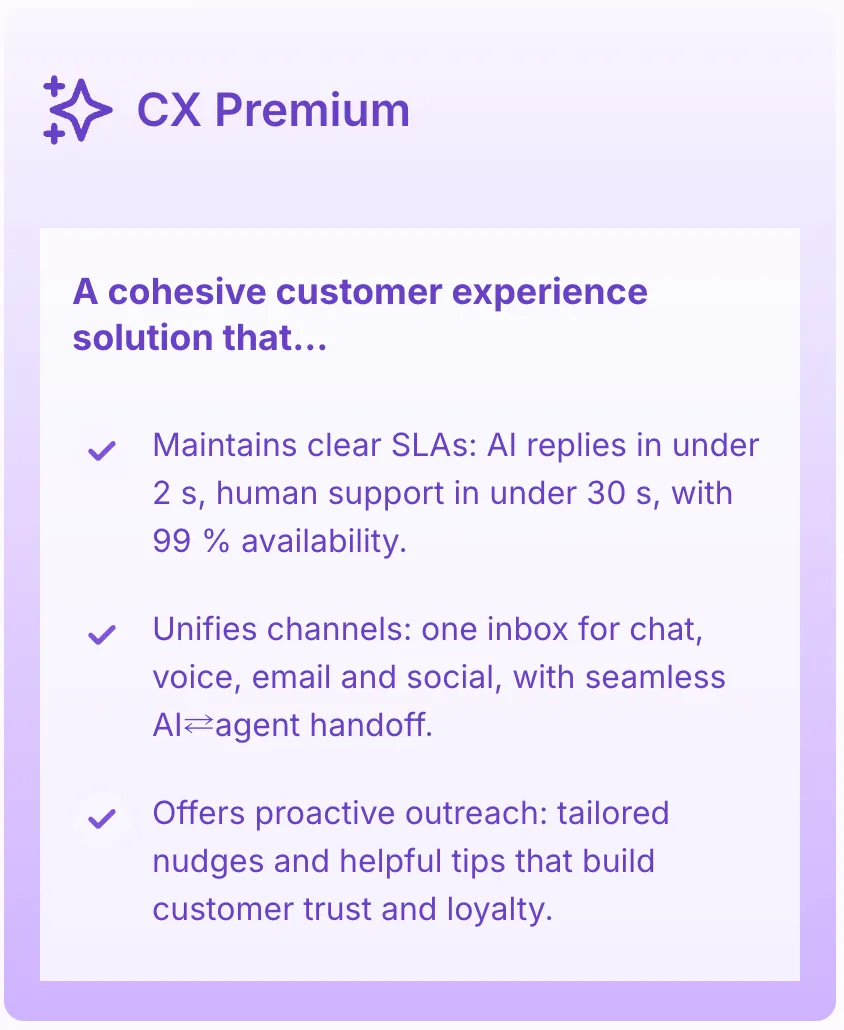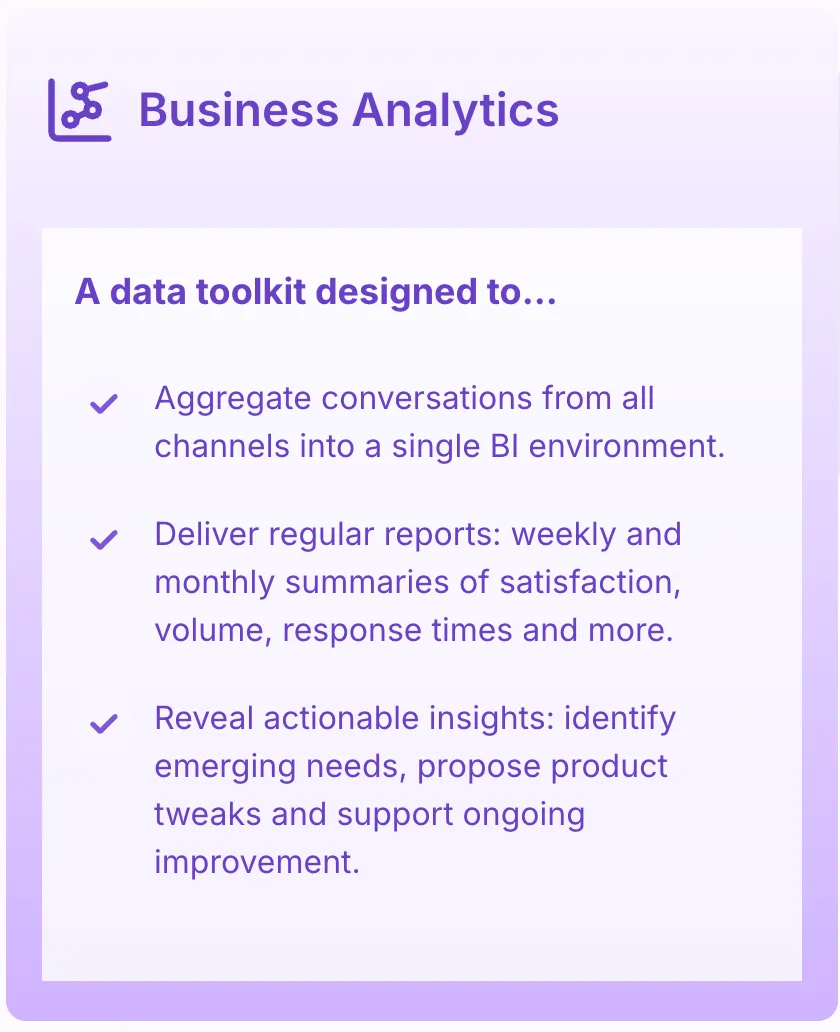Today's customers want smooth, emotionally aware conversations across different channels. They expect quick solutions, personalized attention, and easy experiences. Because of this shift, businesses urgently need to track more advanced metrics that measure both efficiency and emotional connection.
In this guide, you'll discover:
- The most important customer service metrics for 2025
- How to measure the effectiveness of AI-powered service
- Ways to track emotional intelligence in customer interactions
- Methods to balance automation with human touch
- Strategies to improve your customer satisfaction scores
These 10 essential metrics will help you build a customer service strategy that meets modern expectations. You'll learn how to measure everything from customer effort scores to AI containment rates, enabling you to deliver exceptional service experiences that drive loyalty and growth.
Let's dive into the metrics that will shape the future of customer service excellence.

Understanding Customer Service Metrics
Customer service metrics fall into two distinct categories: operational efficiency metrics and experiential metrics. Each plays a unique role in measuring and improving your customer service performance.
1. Operational Efficiency Metrics
- Average Handle Time (AHT)
- First Response Time
- Queue Time
- Resolution Rate
- Cost per Contact
These metrics focus on quantifiable aspects of your service delivery, measuring how efficiently your team processes and handles customer interactions.
2. Experiential Metrics
- Customer Effort Score (CES)
- Net Promoter Score (NPS)
- Customer Satisfaction (CSAT)
- Sentiment Analysis
- Customer Feedback Ratings
Experiential metrics capture the qualitative aspects of customer interactions, revealing how customers feel about their service experience.
Balancing both metric types creates a comprehensive view of your customer service performance. While operational metrics help optimize processes and reduce costs, experiential metrics ensure these efficiency gains don't compromise customer satisfaction.
Consider this example: Your team achieves a low Average Handle Time of 2 minutes per interaction. This operational metric suggests high efficiency. Yet, if your Customer Effort Score reveals customers find these quick interactions unsatisfactory, you've identified a gap between operational success and customer experience.
Modern CX measurement requires this dual approach:
Real-World Application
- Track Average Handle Time alongside Customer Satisfaction scores
- Monitor First Response Time in relation to Customer Effort Score
- Compare Resolution Rate with Net Promoter Score results
This balanced measurement strategy helps you:
- Identify areas where efficiency gains might impact customer experience
- Spot opportunities to improve both speed and satisfaction
- Make data-driven decisions that benefit both your operations and customers
The rise of AI and automation in customer service makes this balanced approach even more critical. As you implement new technologies, tracking both operational and experiential metrics helps ensure your service improvements align with customer expectations.

1. Customer Effort Score (CES): Measuring Ease of Interaction
The Customer Effort Score is a crucial predictor of customer loyalty in 2025's AI-driven service landscape. This metric measures how much effort customers put in to resolve their issues or complete desired actions through your service channels.
Key Components of CES Measurement:
- Analysis of the resolution pathway
- Time spent finding solutions
- Number of interactions needed
- Channel switches required
- Customer feedback on the ease of service
Modern CES calculations use behavioral data and AI-powered conversation analysis to create a comprehensive effort score. You can track specific friction points in customer journeys through:
- Monitoring interactions in real-time
- Predicting effort scores
- Recognizing patterns in customer behavior
- Optimizing service pathways
Improving Your CES:
- Implement smart routing to connect customers with the most qualified agents
- Deploy AI chatbots for instant responses to common queries
- Create seamless handoffs between automated and human support
- Use predictive analytics to anticipate customer needs
- Maintain context across multiple interactions
A strong CES directly impacts customer retention rates - research shows customers are 4x more likely to become disloyal after high-effort experiences. By focusing on reducing customer effort, you create a frictionless service environment that builds long-term loyalty and advocacy.
2. Containment Rate: Effectiveness of Automated Resolution
Containment rate measures the percentage of customer issues successfully resolved through automated systems without human agent intervention. This crucial metric directly reflects your AI-powered self-service effectiveness and operational efficiency.
Calculating Containment Rate:
Containment Rate = (Issues Resolved by Automation / Total Issues) × 100
A high containment rate indicates strong automated support capabilities, leading to:
- Reduced operational costs
- Faster resolution times
- Increased scalability
- 24/7 support availability
Strategies to Improve Containment Rate:
- Enhanced AI Training
- Feed historical support data into AI models
- Update knowledge bases regularly
- Incorporate customer feedback loops
- User Experience Optimization
- Design clear self-service navigation paths
- Implement natural language understanding
- Create intuitive chatbot conversations
- Smart Escalation Protocols
- Set up precise trigger points for human handoff
- Monitor common failure points
- Analyze patterns in unsuccessful containment
Success Indicators:
- 70-80% containment rate for basic inquiries
- 40-50% for moderate complexity issues
- Consistent improvement in resolution accuracy
- Positive customer feedback on automated interactions
Regular analysis of containment patterns helps identify areas where automation can be strengthened, ensuring your self-service channels evolve with customer needs.
3. Agent Assist Utilization: Measuring AI Support for Agents
Agent assist utilization measures how effectively agents leverage AI tools during customer interactions. This metric calculates the percentage of agent interactions that incorporate AI assistance using a simple formula:
Agent Assist Utilization (%) = (Interactions with AI-Assisted Agent Actions / Total Agent Interactions) × 100
Integrating AI recommendations into agent workflows creates significant benefits:
- Reduced Response Time: AI suggests relevant responses based on historical data
- Enhanced Accuracy: Agents access real-time knowledge base updates
- Consistent Service Quality: Standardized responses for common inquiries
- Improved Agent Confidence: Data-backed suggestions support decision-making
Creating effective feedback loops strengthens AI assistance quality:
- Track Usage Patterns
- Monitor which AI suggestions agents accept or reject
- Identify high-performing AI recommendations
- Document cases where AI assistance falls short
- Implement Agent Feedback Systems
- Enable quick rating of AI suggestions
- Collect specific improvement notes
- Record successful resolution examples
- Regular Performance Reviews
- Analyze AI suggestion accuracy rates
- Review agent adoption patterns
- Identify training opportunities
Setting target utilization rates helps teams maximize AI tool benefits while maintaining human judgment in complex scenarios. Regular monitoring ensures AI suggestions remain relevant and valuable to your support team.
4. Resolution Quality Index (RQI): Comprehensive Outcome Measurement
The Resolution Quality Index (RQI) provides a sophisticated measurement framework that goes beyond simple "resolved" or "unresolved" status. This metric combines four critical components to evaluate the true effectiveness of issue resolution:
RQI Components and Calculation:
RQI = (w₁ × Accuracy) + (w₂ × Completeness) + (w₃ × First-Time-Right) + (w₄ × Durability)
Each component plays a vital role in measuring resolution quality:
- Accuracy: Measures the correctness of the solution provided
- Completeness: Evaluates if all aspects of the customer's issue were addressed
- First-Time-Right: Tracks whether the issue was resolved in the initial interaction
- Durability: Assesses if the solution prevents similar issues from recurring
Best Practices for RQI Improvement:
- Implement AI-powered post-resolution verification checks
- Build comprehensive knowledge management systems with regular updates
- Track resolution patterns across different channels (AI-only, human-only, hybrid)
- Conduct root cause analysis on recurring issues
- Adjust component weights based on changing business priorities
RQI helps identify gaps in your service delivery by analyzing the quality differences between AI and human interactions. By monitoring these metrics, you can optimize your knowledge base, enhance agent training programs, and refine AI algorithms for better customer outcomes.
5. Channel Transition Efficiency (CTE): Seamless Omnichannel Experience
Channel Transition Efficiency measures how smoothly customer interactions transfer between different communication channels. A high CTE score indicates customers can switch from chat to email to phone without repeating information or losing context.
The CTE formula combines four key components:
- Context Retention (40%)
- Time Efficiency (30%)
- Customer Effort (20%)
- Resolution Continuity (10%)
Practical strategies to boost your CTE score:
- Implement unified customer profiles accessible across all channels
- Use AI-powered context mapping to automatically transfer conversation history
- Deploy smart routing algorithms that direct customers to the most appropriate channel
- Enable real-time data synchronization between different communication platforms
Your CTE optimization efforts should focus on:
- Automated Context TransferAI systems that capture and relay relevant customer information
- Smart summaries of previous interactions
- Predictive analysis of customer needs
- Analytics-Driven ImprovementsTrack common transition points between channels
- Identify bottlenecks in the transition process
- Measure context retention rates
Modern unified analytics platforms can help you monitor CTE performance by providing detailed insights into cross-channel customer journeys. These platforms track metrics like context preservation rates and transition times, helping you identify areas for improvement in your omnichannel strategy.
6. Net Promoter Score (NPS): Measuring Customer Loyalty and Advocacy
Net Promoter Score is a key metric in customer service, asking one simple yet powerful question: "How likely are you to recommend our service to others?"
The scoring system divides customers into three categories:
- Promoters (9-10): Loyal enthusiasts who fuel growth
- Passives (7-8): Satisfied but unenthusiastic customers
- Detractors (0-6): Unhappy customers who can damage brand reputation
Your NPS calculation follows this formula:
NPS = % Promoters - % Detractors
A high NPS directly links to customer retention rates. Companies with scores above 70 typically see:
- 20-30% higher customer lifetime value
- Reduced acquisition costs through word-of-mouth marketing
- Increased repeat purchase rates
- Greater resistance to competitor offerings
To leverage NPS effectively:
- Track scores across different customer segments
- Analyze feedback patterns from each category
- Implement targeted improvements based on detractor comments
- Create personalized engagement strategies for passives
- Build advocacy programs around promoters
Modern AI-powered systems can automatically categorize NPS feedback, identify trending issues, and suggest actionable improvements. This real-time analysis helps you address concerns quickly and transform detractors into promoters through proactive service interventions.
7. First Contact Resolution (FCR): Efficiency in Solving Issues Quickly
First Contact Resolution stands as a critical metric measuring your support team's ability to solve customer issues without follow-up interactions. A high FCR rate directly impacts customer satisfaction - when customers get their problems solved immediately, they're less likely to feel frustrated or abandon your brand.
Key Benefits of High FCR Rates:
- Reduced operational costs by eliminating multiple touchpoints
- Increased customer satisfaction through immediate problem resolution
- Lower customer churn rates
- Improved agent productivity and efficiency
AI-Powered Solutions for Better FCR:
- Real-time knowledge base suggestions for agents during customer interactions
- Predictive analytics to identify common issue patterns
- Automated routing to the most qualified agent based on issue type
- Smart templates and response recommendations
The integration of AI tools helps agents access relevant information instantly, leading to faster and more accurate resolutions. AI systems analyze historical data to predict potential solutions, while machine learning algorithms continuously improve suggestion accuracy based on successful resolution patterns.
Measuring FCR Performance:
FCR Rate = (Issues Resolved on First Contact / Total Issues) × 100
A healthy FCR rate typically ranges between 70-75%, though this can vary by industry and complexity of support issues. Regular monitoring of this metric helps identify areas where additional training or AI assistance might be needed to improve resolution rates.
8. Sentiment Analysis & Sentiment Shift Score: Tracking Emotional Dynamics
Natural Language Processing (NLP) technology enables real-time tracking of customer emotions during service interactions. This advanced analysis captures subtle changes in tone, word choice, and expression patterns to create a dynamic emotional journey map.
Key Components of Sentiment Analysis:
- Real-time emotion detection
- Contextual language understanding
- Tone pattern recognition
- Expression intensity measurement
The Sentiment Shift Score measures emotional changes throughout a customer interaction. A positive shift indicates successful emotional handling, while a negative shift signals potential issues requiring immediate attention.
Practical Applications:
- Identifying trigger points that cause customer frustration
- Spotting opportunities for proactive intervention
- Training agents on emotional intelligence
- Refining automated response systems
AI-powered sentiment analysis helps service teams detect early warning signs of customer dissatisfaction. When the system identifies negative emotional patterns, it can automatically:
- Alert supervisors for immediate intervention
- Suggest appropriate responses to agents
- Route complex cases to specialized teams
- Document emotional patterns for future reference
Companies using sentiment analysis report a 25% reduction in escalations and a 30% improvement in customer satisfaction scores. The technology proves particularly valuable in high-stakes interactions where emotional understanding plays a crucial role in resolution success.
9. Cost Per Resolution (CPR): Balancing Quality with Operational Expenses
Cost Per Resolution (CPR) is an important financial metric that measures the average expense required to resolve a customer issue. This metric helps businesses maintain a healthy balance between delivering exceptional customer service and managing operational costs.
Why CPR Matters:
- Identifies resource allocation efficiency
- Highlights areas for cost optimization
- Enables data-driven budgeting decisions
- Reveals the true cost impact of different support channels
Calculating CPR:
CPR = Total Support Costs / Number of Resolved Cases
To reduce CPR while maintaining service quality, consider these proven strategies:
1. Implement AI-powered self-service options
- Chatbots for common inquiries
- Knowledge base optimization
- Automated ticket routing
2. Enhance agent productivity
- AI-assisted response suggestions
- Streamlined workflows
- Targeted training programs
3. Optimize channel mix
- Direct customers to cost-effective channels
- Analyze channel-specific resolution costs
- Balance automated and human support
Smart Cost Management Tips:
- Track CPR variations across different issue types
- Monitor the relationship between CPR and customer satisfaction scores
- Invest in preventive measures to reduce ticket volume
- Regular analysis of high-cost resolution patterns
Remember: A lower CPR shouldn't come at the expense of customer satisfaction. Focus on efficiency improvements that maintain or enhance the quality of service delivery.
10. Unified Analytics Platform & Benchmarking Customer Service Metrics
A unified analytics platform transforms scattered customer service data into actionable insights. By consolidating metrics from multiple channels - chat, voice, email, social media - you gain a comprehensive view of your customer service performance.
Key Features of an Effective Analytics Platform:
- Unique customer identifiers across channels
- Real-time data synchronization
- Custom dashboard creation
- Automated reporting capabilities
- Global scalability options
- Multi-language support
- API integration flexibility
The platform should enable data-driven decision making through advanced analytics capabilities:
- Predictive modeling
- Trend analysis
- Cross-channel performance comparison
- Custom metric creation
- Automated anomaly detection
Case Study: Healthcare Provider Success with Yellow.ai
A leading healthcare provider implemented Yellow.ai's unified analytics solution to address their fragmented customer service data. The results demonstrated significant improvements:
- 27% increase in First Contact Resolution
- Real-time visibility across 12 service channels
- Standardized measurement across global operations
- Automated performance benchmarking against industry standards
The success stemmed from Yellow.ai's enterprise-grade analytics architecture, which enabled consistent measurement standards while maintaining regional flexibility. The platform's robust integration ecosystem allowed seamless connection with existing tools, creating a single source of truth for all customer service metrics.

Best Practices for Leveraging AI & Automation Metrics Together
The future of customer service lies in the seamless integration of AI and human capabilities. Here's how you can optimize your metrics strategy for hybrid human-AI collaboration:
1. Create Balanced Scorecards
- Combine AI performance metrics with human agent KPIs
- Weight metrics based on interaction complexity
- Track both efficiency gains and emotional connection scores
- Measure knowledge sharing between AI and human agents
2. Implement Real-Time Performance Monitoring
- Set up automated alerts for metric deviations
- Enable instant feedback mechanisms for AI recommendations
- Monitor sentiment shifts during channel transitions
- Track resolution pathways across AI and human touchpoints
3. Design Data-Driven Feedback Loops
- Run A/B tests on AI responses and routing decisions
- Analyze patterns in escalations from AI to human agents
- Use machine learning to identify successful resolution strategies
- Adjust AI training based on human agent performance data
4. Build Trust Through Transparency
- Share performance metrics with both customers and agents
- Display AI confidence scores for suggested responses
- Document the reasoning behind automated decisions
- Maintain clear accountability for resolution outcomes
The key to success lies in treating AI and human agents as complementary forces. Your metrics should reflect this partnership:
Resolution Quality = (AI Accuracy × Speed) + (Human Empathy × Complexity Handling)
By measuring both operational excellence and emotional authenticity, you create a comprehensive view of service quality. This approach helps you:
- Identify optimal handoff points between AI and humans
- Reduce customer effort across all interaction types
- Improve first-contact resolution rates
- Build stronger emotional connections with customers
Remember to regularly calibrate your metrics based on customer feedback and changing service expectations. The goal is to create a measurement framework that evolves with your hybrid support model.
FAQs (Frequently Asked Questions)
What are the key differences between operational and experiential customer service metrics ?
Operational metrics focus on efficiency aspects like Average Handle Time, while experiential metrics emphasize customer perceptions such as Customer Effort Score (CES). Balancing both types is critical for a comprehensive understanding of customer experience (CX) and effective CX measurement in modern customer service.
How does the Customer Effort Score (CES) predict customer loyalty in 2025 ?
CES measures how easy it is for customers to interact and resolve their issues. Lower effort scores correlate strongly with higher loyalty, as customers prefer effortless resolutions. Tracking CES through resolution pathway analysis and predictive scoring helps organizations enhance ease of interaction, thereby boosting loyalty.
What is Containment Rate and why is it important in AI-powered self-service ?
Containment Rate represents the percentage of customer issues resolved without human intervention, reflecting the effectiveness of automated solutions. High containment rates indicate successful AI-powered self-service strategies, reducing operational costs and improving customer satisfaction by providing instant resolutions.
How does Agent Assist Utilization improve agent performance with AI support ?
Agent Assist Utilization measures how frequently agents use AI recommendations during interactions. Integrating AI into agent workflows enhances decision-making, speeds up resolution times, and builds trust in AI tools. Continuous feedback loops help refine AI assistance quality, leading to improved overall service.
Why is Channel Transition Efficiency (CTE) crucial for an omnichannel customer experience ?
CTE assesses how smoothly customers move between communication channels without losing context. Optimizing CTE ensures seamless interactions across platforms, enhancing satisfaction and reducing frustration. Leveraging AI recommendations and unified analytics platforms can significantly improve channel transitions.
What role does a Unified Analytics Platform play in benchmarking customer service metrics ?
A Unified Analytics Platform consolidates data from multiple channels into a single system, enabling consistent measurement of key metrics like First Contact Resolution (FCR). Features such as unique customer identifiers and global scalability allow organizations to benchmark performance effectively and implement data-driven improvements across all touchpoints.









